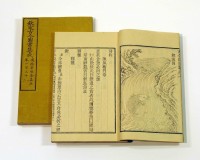 |
| Articles on archives, rare books, the Chinese Classics Full-text Database, and stone and bronze rubbings. |
|
|
A Note on the Luxuriance of the Island: A Collection of Forestry Literature of the Japanese Colonial Period |
|
 During the Japanese colonial period, Taiwan’s economy mirrored that of a typical colony whose available manpower and natural resources are utilized in ways that conform to the overall planning for the development of the mother country. Thus, one major policy of Taiwan Governor-General’s Office was to tap and channel the island’s agricultural, forest, and animal husbandry resources to the service of the colonial power, which in turn culminated in the first ever large-scale survey on Taiwan’s economic resources. This colonial undertaking not only made up for Japan’s lack of research on tropical timber, but also served as the first step in recognizing Taiwan as an integral component of the Japanese empire’s supply chain. The results of the surveys furnished a sound basis for the economic development of Taiwan during the Japanese colonial period and the early years after the restoration of Taiwan to the Nationalist Government.
During the Japanese colonial period, Taiwan’s economy mirrored that of a typical colony whose available manpower and natural resources are utilized in ways that conform to the overall planning for the development of the mother country. Thus, one major policy of Taiwan Governor-General’s Office was to tap and channel the island’s agricultural, forest, and animal husbandry resources to the service of the colonial power, which in turn culminated in the first ever large-scale survey on Taiwan’s economic resources. This colonial undertaking not only made up for Japan’s lack of research on tropical timber, but also served as the first step in recognizing Taiwan as an integral component of the Japanese empire’s supply chain. The results of the surveys furnished a sound basis for the economic development of Taiwan during the Japanese colonial period and the early years after the restoration of Taiwan to the Nationalist Government.
|
|
Read more...
|
|
|
Let Theses Come Alive: the Sotsugyou Honbun |
|
 Can you recall Uncle Kunbin’s image in the movie “Let It Be: The Last Rice Farmers”? The movie records how Taiwan’s geographical characteristics, an island of many mountains yet few plains, have impacted the agricultural condition and captures the farmer’s diligent and laborious faces. By watching the movie either in a cinema or on DVD, the audience can understand the simple life philosophy of this land. Nowadays, however, animal power is replaced with machine power; the ubiquitous scenes of buffalo plowing are now but dissolving memory of the past. Back in the Japanese colonial period, the Office of the Governor-General’s highest policy was “industrial Japan and agricultural Taiwan,” which laid the foundation for Taiwan’s agricultural development. In an era when image technology was yet budding, research data from fields such as soil science, vegetation science, and agricultural economy were preserved through old-time methods. Such research data restore the distinctive styles in different eras, and await for discovery and appreciation.
Can you recall Uncle Kunbin’s image in the movie “Let It Be: The Last Rice Farmers”? The movie records how Taiwan’s geographical characteristics, an island of many mountains yet few plains, have impacted the agricultural condition and captures the farmer’s diligent and laborious faces. By watching the movie either in a cinema or on DVD, the audience can understand the simple life philosophy of this land. Nowadays, however, animal power is replaced with machine power; the ubiquitous scenes of buffalo plowing are now but dissolving memory of the past. Back in the Japanese colonial period, the Office of the Governor-General’s highest policy was “industrial Japan and agricultural Taiwan,” which laid the foundation for Taiwan’s agricultural development. In an era when image technology was yet budding, research data from fields such as soil science, vegetation science, and agricultural economy were preserved through old-time methods. Such research data restore the distinctive styles in different eras, and await for discovery and appreciation.
|
|
Read more...
|
|
You Can Find Your Footprint in My Song |
|
 Syaman Rapongan listens attentively to a familiar voice pouring from the speakers — a piece of memory that his father has left behind. The melodious singing unfolds like the steady ocean tide, enchanting listeners with its clarity. Each wave seems to reflect the lives of Lanyu islanders, and the foam brought in by the tide remains on the shore like the memories of days gone by. The song is carried away by the ocean breeze, leaving behind lingering regrets and remembrance.
Syaman Rapongan listens attentively to a familiar voice pouring from the speakers — a piece of memory that his father has left behind. The melodious singing unfolds like the steady ocean tide, enchanting listeners with its clarity. Each wave seems to reflect the lives of Lanyu islanders, and the foam brought in by the tide remains on the shore like the memories of days gone by. The song is carried away by the ocean breeze, leaving behind lingering regrets and remembrance.
|
|
Read more...
|
|
|
A Century of Resilient Tradition: Exhibition of the Republic of China's Diplomatic Archives |
|
 The Ministry of Foreign Affairs (MOFA) of the Republic of China (Taiwan) has not only inherited a fine diplomatic tradition that began with the nation’s founding, but also accumulated a vast quantity of precious historical documents that dates back to the establishment of the Tsung-li ya-men (Office of Foreign Affairs) in 1861. ......
The Ministry of Foreign Affairs (MOFA) of the Republic of China (Taiwan) has not only inherited a fine diplomatic tradition that began with the nation’s founding, but also accumulated a vast quantity of precious historical documents that dates back to the establishment of the Tsung-li ya-men (Office of Foreign Affairs) in 1861. ......
|
|
Read more...
|
|
Rare Books and Secret Archives: Treasures from the Collections of the National Palace Museum |
|
 The National Palace museum is home to a rich collection of approximately 203,000 volumes of rare books and nearly 400,000 pieces of historical documents from the Qing archives. Large in number, these materials are of great cultural and historical value. ......
The National Palace museum is home to a rich collection of approximately 203,000 volumes of rare books and nearly 400,000 pieces of historical documents from the Qing archives. Large in number, these materials are of great cultural and historical value. ......
|
|
Read more...
|
|
|
|
|
<< Start < Prev 1 2 3 4 5 6 7 8 9 10 Next > End >>
|
|
Page 2 of 14 |